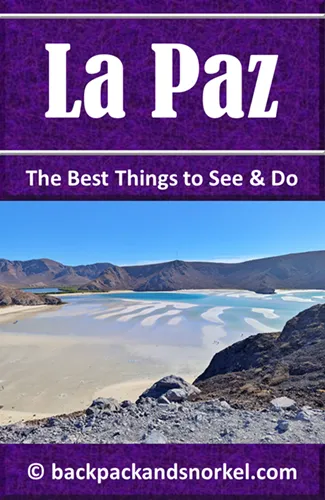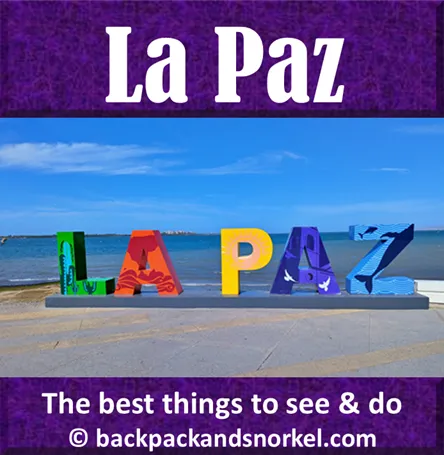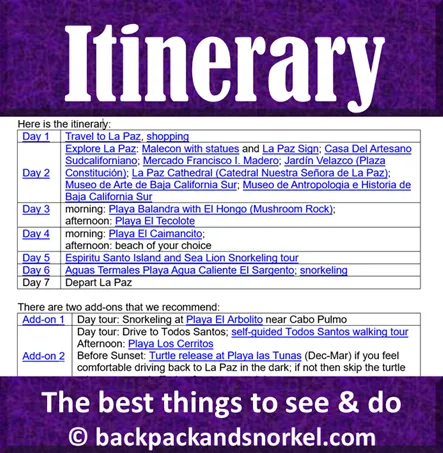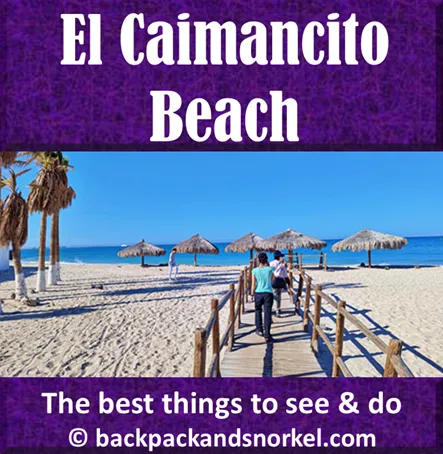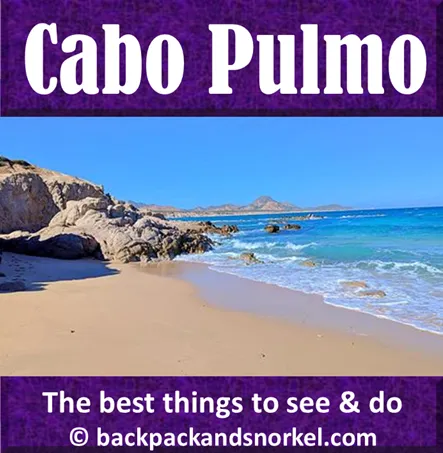Discover Playa Agua Caliente: El Sargento's Unique Beach Hot Pools & Snorkeling Fun! - La Paz Purple Travel Guide
For a special experience in Baja California Sur, venture about 32 miles (51 km) east of La Paz to the laid-back community of El Sargento and discover Aguas Termales Playa Agua Caliente (Hot Water Beach). This isn't your typical hot springs resort; it's a beach with a natural phenomenon where geothermal heat from beneath the earth warms the sand, which in turn heats the shallow seawater, creating a series of impromptu, warm pools right on the edge of the Sea of Cortez.
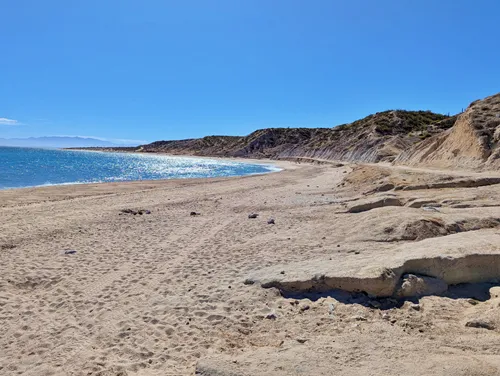
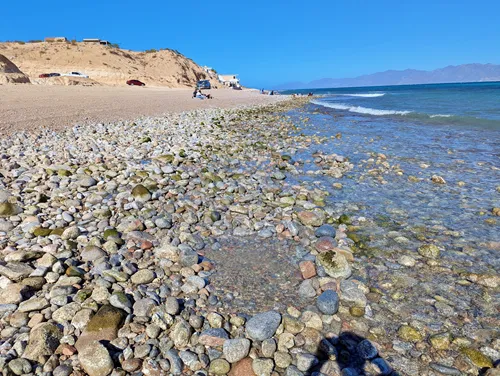
Here at Backpack and Snorkel Travel Guides, we typically promote self-guided walking tours.
But we realize that not everybody likes to walk by themselves in a foreign city. So, just in case that you rather go with ab guide: NO PROBLEM! Please see the Viator tours below.
paid Viator tours
Nature's Own Hot Tubs: How the Springs Form
The ‘attractions’ at Playa Agua Caliente are entirely natural and have been formed over millennia by geothermal activity. The Baja California peninsula sits on a geologically active area.
The heat at Playa Agua Caliente, El Sargento, comes from geothermal activity associated with the tectonic processes that formed the Baja California Peninsula and the Gulf of California.
More precisely:
Rifting and Extension: The Baja California Peninsula is actively rifting away from the North American mainland, forming the Gulf of California. This process involves significant tectonic plate movement and extensional faulting.
Deep Magma/Hot Rock: This rifting and thinning of the Earth's crust allows for magma (molten rock) to be closer to the surface, or at least for the Earth's deeper, hotter layers to be more accessible. While you will not see direct volcanic eruptions at the surface, there is a substantial heat source underground.
Heat Conduction: This deep heat is conducted upwards through the rock layers and the sand.
Heated Groundwater/Seawater Interaction: The warmth from this underground heat source warms the sand. When the ocean water comes in with the tide, it flows over and saturates this superheated sand, causing the seawater itself to become warm. There might also be some degree of geothermally heated groundwater that mixes with the seawater, especially during low tide when the ‘springs’ are more evident, but the primary mechanism for the ‘hot beach’ effect is the transfer of heat from the hot sand to the seawater.
Visiting Aguas Termales
When the ocean tide comes in, the shallow seawater flowing over this heated sand quickly warms up, creating natural ‘hot tubs’ where visitors can relax.
The formation of these unique warm pools is an ongoing process, influenced by the tides. At low tide, when the ocean water recedes, the heated sand is more exposed, and visitors sometimes bring small shovels to dig their own personalized pools in the sand. As the tide gradually returns, or as waves wash over the sand, these dug-out areas fill with the naturally heated seawater, allowing visitors to control the mix of hot and cooler ocean water for the perfect temperature.
Warning: The sand and/or the water can be quite hot, so caution is advised when walking or digging. I am serious: in some areas the water gets very hot and can burn you! Always test the temperature by briefly (!) sticking your toes into the water first.
There is another hot water beach in Hahei, New Zealand, but the water at Aguas Termales Playa Agua Caliente El Sargento gets hotter than in New Zealand.
To find the hot water area, drive to the parking area (map) directly near the beach. You will ideally come halfway between high and low tide (tide_calendar1, tide_calendar2). Do not come at or near high tide, as all hot areas will be covered by water. If you come too close to low tide, then the pools will either have no water at all, or the water they have will be too hot to touch.
The areas where the sand and water are hot are covered with of stones. For this reason, and because the ground and the water are very hot in some areas, we strongly recommend that you wear water shoes. There is no need to dig holes as with other Hot Water beaches.
The best areas are straight down from the parking area to the water and a little to the right. Right where the stone-covered area starts. If you look closer, you will see that previous visitors have built several small pools with the stones. This is a good start, but don’t leave it with this. Explore nearby areas and you will find more hot spots. Over time, the hot spots move, so not all the small pools will be hot anymore.
This is Premium Content! To access it, please download our
Backpack and Snorkel Purple Travel Guide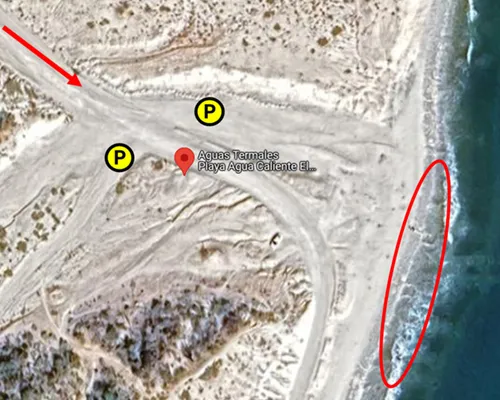
P = car parking
red arrow = direction that you will come from
red oval = area with hot spots
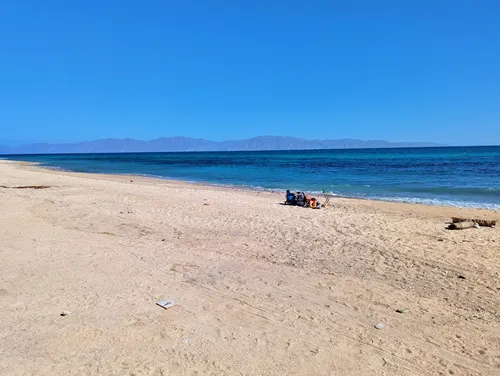

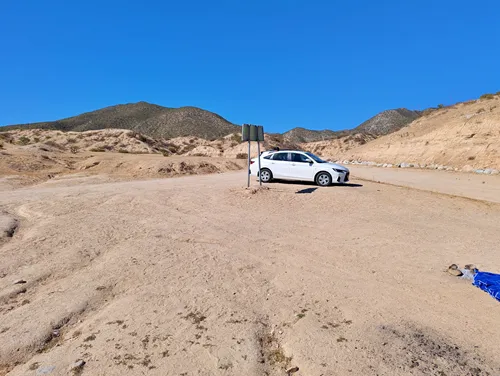

More Than Just Soaking: Snorkeling at Agua Caliente
While the main draw is undoubtedly the natural warm pools, Playa Agua Caliente also offers some serene and solitary sunbathing, and snorkeling.
The best snorkeling can be found by walking south on the beach for about 1,000 ft (300 m) and go into the water where you can see a dark discoloration in the water – this is the reef.
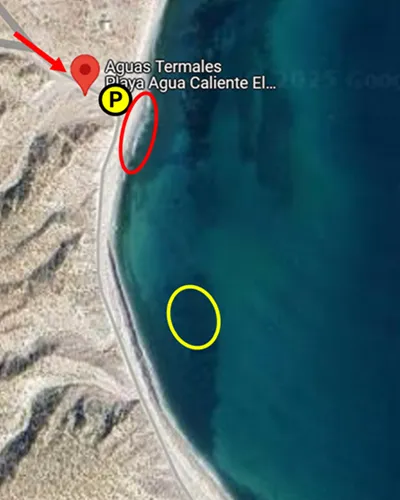
P = car parking
red arrow = direction that you will come from
red oval = area with hot spots
yellow oval = snorkeling



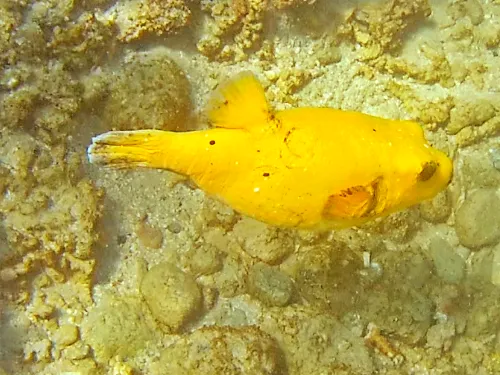
KM-0 Italian Coffee Food & Bakery
When you drive back to La Paz, we recommend stopping at KM-0 Italian Coffee Food & Bakery (map, reviews). We really liked this small and nice and relaxing coffee shop and bakery in the small town of El Sargento. They also have bathrooms, speak English, and accept credit cards. We think it is a perfect stop before you take the drive back to La Paz.
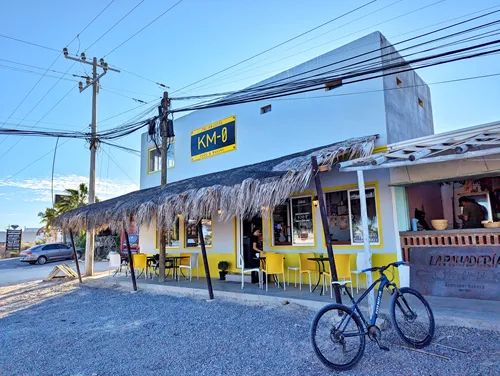
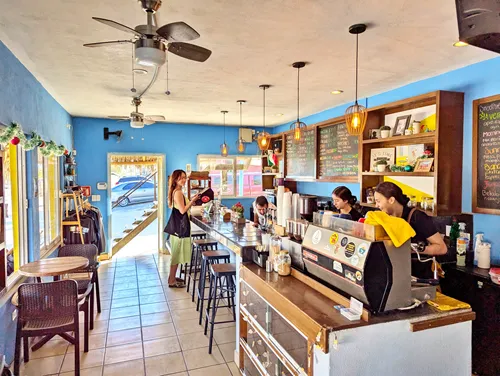
Where do you want to go now?
Author: Rudy at Backpack and Snorkel
Bio: Owner of Backpack and Snorkel Travel Guides. We create in-depth guides to help you plan unforgettable vacations around the world.
Other popular Purple Travel Guides you may be interested in:
Like this Backpack and Snorkel Purple Travel Guide? Pin these for later:
